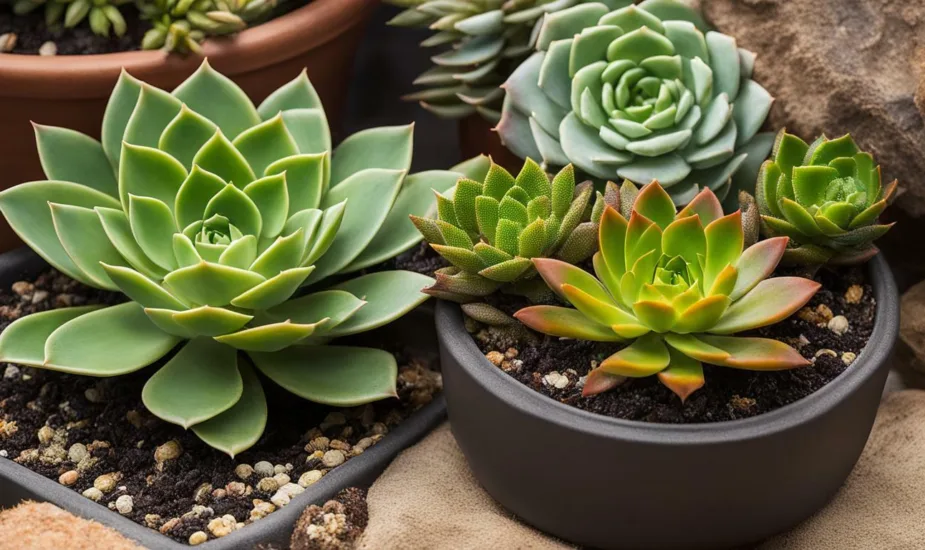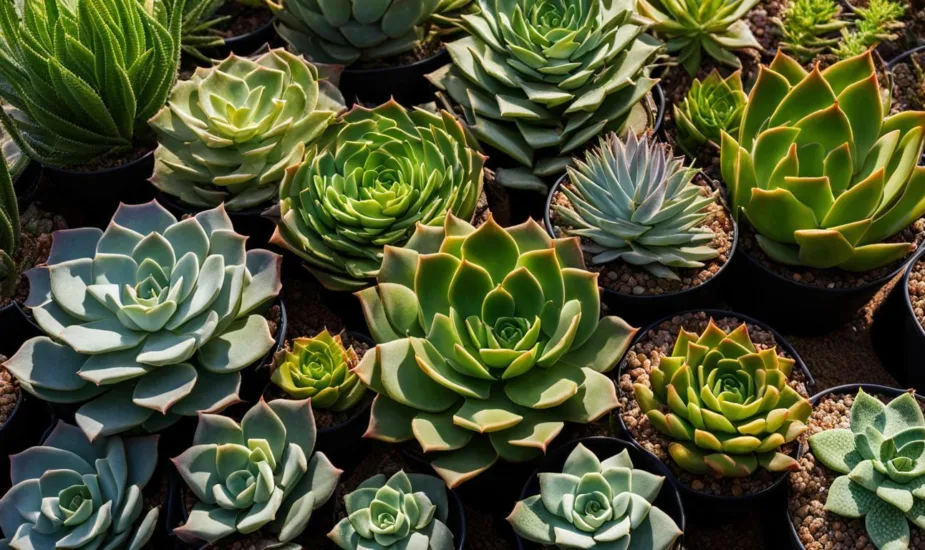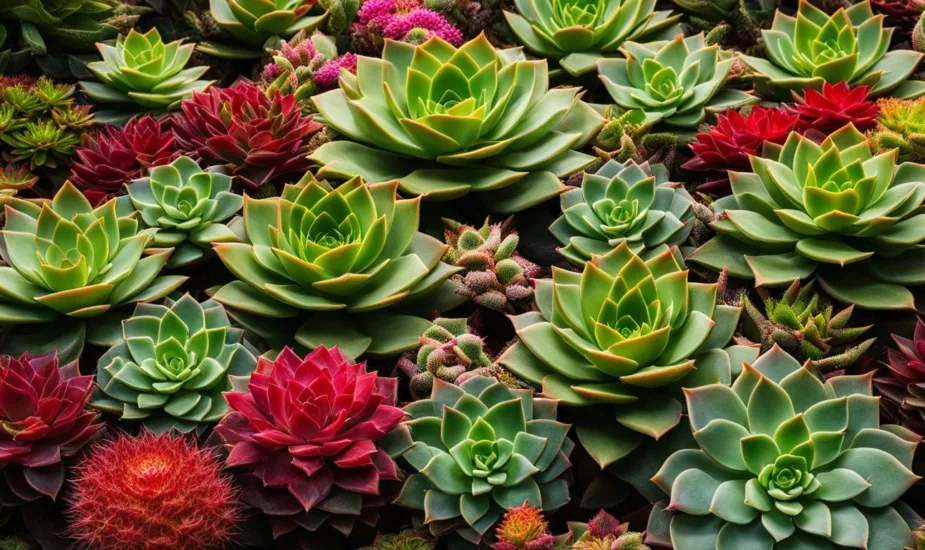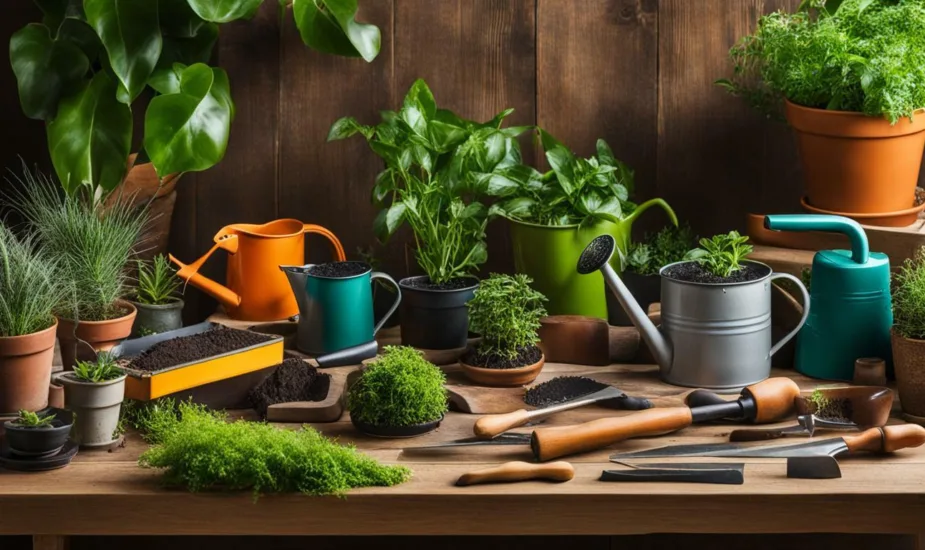From Ground to Sky: Vertical Gardening for Bountiful Vegetables
Vertical gardening has become increasingly popular in recent years as it allows individuals to grow plants in limited spaces such as balconies, rooftops, and small gardens. This method of gardening involves maximizing the use of vertical space and reducing the need for bending and kneeling.
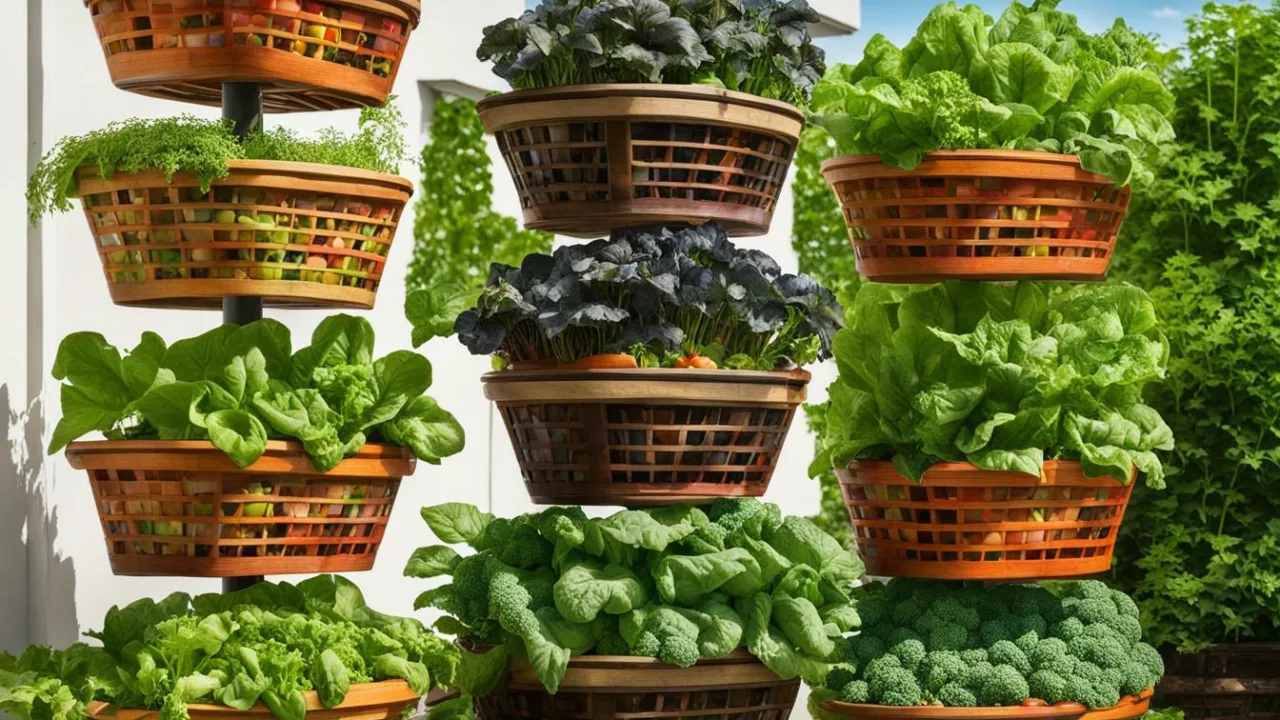
Apart from being space-efficient, vertical gardening can result in bountiful vegetable harvests while keeping the plants safe from pests and rot.
Key Takeaways
- Vertical gardening is ideal for those with limited space, such as balconies and rooftops.
- It allows for bountiful vegetable harvests while keeping plants safe from pests and rot.
- The use of trellises, tripods, and arches can support vertical gardens and aid in plant growth.
Vertical Gardening Ideas for Bountiful Vegetables
Vertical gardening has become a popular way to make efficient use of space and maximize harvest, and there are many creative ideas for growing vegetables in limited areas. One great vertical vegetable gardening idea is the use of a ‘Skyscraper’ Trellis. This trellis can be used to grow climbing vegetables like cucumbers, tomatoes, pumpkins, sweet peas, and beans. It is a space-saving method that also reduces snail and slug damage. Another option for vertical gardening is the use of vertical gardening pockets. These pockets can be used to grow a variety of plants, including flowers, vegetables, strawberries, and even hanging plants. They are suitable for indoor and outdoor walls and fences.
If you’re looking for unique ideas for your vertical garden, consider repurposing teapots. They can be transformed into charming vertical vegetable gardens, perfect for small spaces. Teapots are ideal for growing herbs, geraniums, and even tomatoes. Another simple and effective option is the bucket frame. This idea involves using buckets on a frame to create a vertical garden. It’s practical and fun, making it a great way to involve children and teach them gardening skills.
If you want to add an artistic touch to your vertical garden, consider using upcycled ladder and planks or vintage window frames. These materials create an aesthetically pleasing design that can be used as a potting station or even a peekaboo wall. For a more unique look, colander hanging baskets can also be used to grow vegetables and add a touch of creativity to your garden.
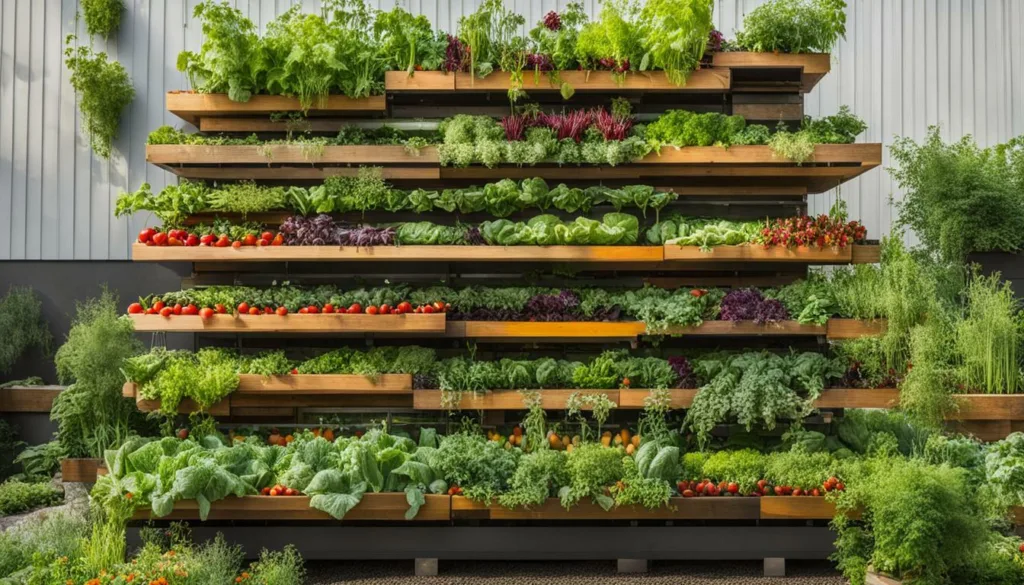
Overall, there are many vertical gardening ideas to choose from when it comes to growing bountiful vegetables in limited spaces. Choosing vining or climbing varieties of vegetables is key to maximizing space, and creating a garden map can help with layout and planning. With the right tools and materials, anyone can enjoy the benefits of vertical gardening and have a thriving vegetable garden, no matter how small their space is.
‘Skyscraper’ Trellis for Climbing Vegetables
This wall system allows for the growth of various climbing vegetables such as cucumbers, tomatoes, pumpkins, sweet peas, and beans. The ‘Skyscraper’ Trellis is a popular vertical gardening method that maximizes space and allows for the efficient use of limited gardening areas. It is a sturdy and space-saving solution that keeps vegetables off the ground, away from pests and rot. The trellis can be used to grow a variety of vegetables and is available as a kit made with quality materials like cedar wood and steel, ensuring durability and strength.
| Benefits of ‘Skyscraper’ Trellis |
|---|
| Maximizes space and allows for efficient use of limited gardening areas |
| Keeps vegetables off the ground, away from pests and rot |
| Reduces snail and slug damage by keeping plants elevated |
| Sturdy and space-saving solution |
The ‘Skyscraper’ Trellis is a versatile solution for vertical gardening enthusiasts and can be used to grow various vegetables. It reduces the need for bending and kneeling, making it a practical solution for gardeners with physical limitations. By keeping the plants elevated, it reduces the impact of pests, snails, slugs, and rot. Additionally, it allows for efficient use of space and maximizes harvests. Overall, the ‘Skyscraper’ Trellis is a practical and popular solution for climbing vegetables.
Vertical Gardening Pockets for Versatile Planting
Vertical gardening pockets are a popular and versatile way to grow plants in small spaces. They maximize harvest and make efficient use of limited space, allowing gardeners to grow vegetables, herbs, and flowers on indoor and outdoor walls and fences.
Another vertical gardening idea is the use of vertical gardening pockets on walls, which provides a unique and creative way to grow plants in small spaces. These pockets come in a variety of sizes and can be used to grow a variety of vegetables, such as lettuce, spinach, and cucumbers, as well as herbs and flowers, such as strawberries, petunias, and marigolds. The pockets are typically made out of durable, breathable material and provide good drainage to prevent water damage. They can be easily mounted onto walls and fences, adding a decorative touch to any garden space.
Vertical gardening pockets are also a great way to keep vegetables away from pests and rot. By lifting the plants off the ground, gardeners can avoid constant bending and kneeling, reducing physical strain and making it easier to maintain the garden. Additionally, vertical gardening pockets can be easily moved around and rearranged to suit changing sunlight and shade patterns, ensuring that plants receive the optimal amount of sunlight.
When creating a garden map for vertical gardening pockets, it is important to measure the garden space and take into account obstacles, sunlight, and shade patterns. A garden map can help with planning the layout and placement of seeds and plants, maximizing space and harvest. It is also important to choose the right crops for vertical gardening, such as vining varieties that can be trained to grow up the pockets.
Overall, vertical gardening pockets provide a versatile and practical way to grow plants in small spaces, adding color and life to any indoor or outdoor wall or fence.

Repurposing Teapots for Unique Vertical Gardens
Teapots can also be repurposed for vertical gardening, providing a creative and unique touch to your garden. Vertical gardening has become increasingly popular as it allows for efficient use of limited space, making it ideal for balconies, rooftops, or small garden beds. By keeping plants off the ground, teapots can help prevent pest infestations and rot, while also providing a visually appealing method of growing herbs, flowers, or even tomatoes.
When planning a vertical garden using a teapot, it is important to choose the right plants that can climb or be trained to grow vertically. Geraniums, herbs, and even cherry tomatoes are perfect for this setup, providing both a decorative touch and practical use.

Other ideas for vertical gardening include using trellises, buckets, ladders, or vintage window frames. These items can be repurposed and upcycled to create unique displays in your garden. Additionally, using a garden map can help in organizing and maximizing the space available.
Vertical gardening can also be a fun and educational activity for children, teaching them valuable gardening skills while providing a practical way to water and care for plants. With a little creativity and effort, vertical gardening can be a practical and aesthetically pleasing addition to any garden or small space.
Simple and Effective Bucket Frame Gardening
Using buckets on a frame is another simple and effective vertical gardening idea. It is a practical and fun way to involve children in gardening and teach them valuable skills such as watering plants and caring for them. By using a frame, the buckets can be positioned at a height that is comfortable for people of all ages and abilities, reducing the need for bending and kneeling.
Bucket frame gardening is also suitable for both indoor and outdoor environments, making it a versatile option. The buckets can be filled with soil and planted with a variety of vegetables and herbs, such as tomatoes, peppers, and basil.
| Pros: | Cons: |
|---|---|
| -Great for limited space | -May need to water more frequently |
| -Easy to set up | -May be challenging to move once set up |
| -Involves children in the gardening process | -May require additional materials |
When using a garden map, it is easy to plan and organize bucket frame gardening. By mapping out the available space and determining where plants should be placed, it is possible to maximize the space and ensure that all plants are placed in the best possible location.
Some tips for successful bucket frame gardening include ensuring that the buckets have drainage holes for excess water, using high-quality soil, and planting in a location with appropriate sunlight and shade. It is also important to regularly water and fertilize the plants to ensure that they are healthy and producing a bountiful harvest.

Overall, bucket frame gardening is a simple and effective method for growing vegetables and herbs. It is practical, fun, and involves children in the gardening process while teaching them valuable skills. By using a garden map and following the tips outlined above, it is possible to have a thriving bucket frame garden that provides a bountiful harvest throughout the growing season.
Aesthetically Pleasing Vertical Garden Designs
Upcycling an old ladder and planks can create a peekaboo wall in the garden. It provides an innovative way to add vertical gardening space in a limited area. The ladder can be installed against a wall and filled with a variety of plants, from flowers to vegetables. The plants can be arranged in ascending order, with the largest at the bottom and the smallest at the top.
Another creative way to improve your vertical garden design is to incorporate a potting station or bench for planting and maintaining your vertical garden. This area can be used to store tools and supplies, making gardening more efficient and enjoyable.
Vintage window frames can also be used for vertical gardening, adding an artistic touch to your space. These frames can be hung on a wall or fence and filled with plants to create a living work of art. It’s important to consider the shade and spacing of your plants to ensure they receive enough sunlight and room to grow.
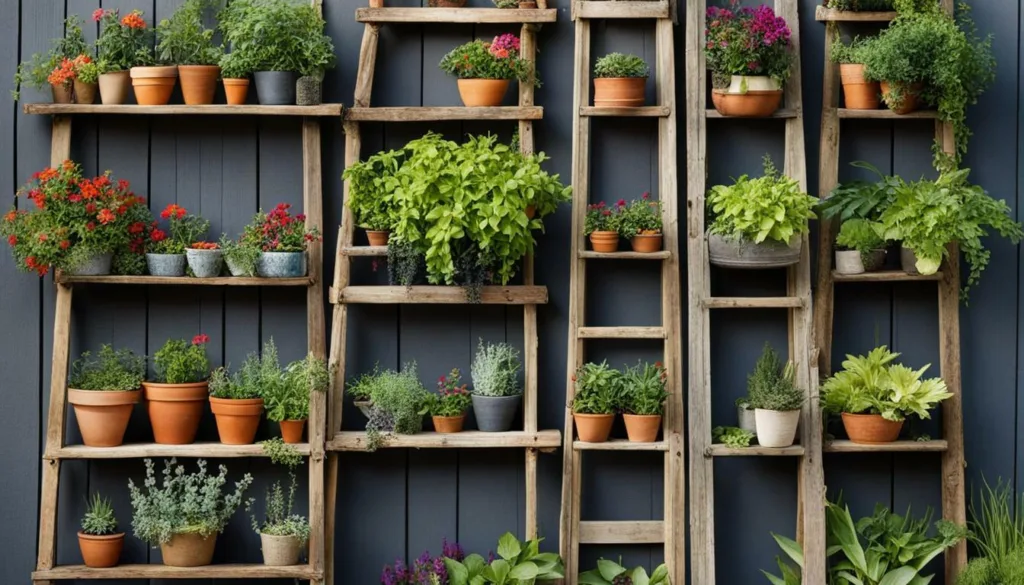
Hiring a landscape architect can take your vertical garden design to the next level. These professionals can create a customized design that fits your specific needs and style. Incorporating structures like arches and living walls can enhance your garden and add visual interest.
When designing your vertical garden, it’s important to take an artistic approach to ensure a visually appealing and functional space. Using upcycled materials like ladders and vintage window frames can add character and personality to your garden. Don’t be afraid to get creative and experiment with different structures and materials to find the perfect design for your space.
Conclusion
In conclusion, vertical gardening is a popular and practical way to grow bountiful vegetables in limited spaces. By utilizing techniques such as ‘Skyscraper’ Trellis for climbing vegetables, Vertical Gardening Pockets for versatile planting, and repurposed teapots for unique vertical gardens, you can efficiently use limited space and maximize your harvest. Simple and effective bucket frame gardening is an activity that can involve children while teaching them gardening skills, making it a practical and enjoyable family activity.
Aesthetically pleasing vertical garden designs, such as using upcycled ladder and planks, peekaboo wall, and vintage window frames, can add a decorative touch to your garden. Landscape architects bring an artistic approach to vertical garden designs, considering factors such as shade and spacing, potting station, and plant companions.
Creating a Garden Map for Maximum Productivity
In addition to these techniques, creating a garden map is an essential step in planning and maximizing the productivity of your vegetable garden. It helps you determine the number of seeds and plants you need as well as their placement for optimal growth. A garden map also allows you to track your garden’s progress year after year and make any necessary changes.
By mapping out your garden and considering factors such as sunlight, plant companions, and crop rotation, you can ensure a successful and bountiful harvest. Remember to keep notes and make adjustments to your map throughout the year, and save it for future reference. Happy gardening!
FAQ
Q: What is vertical gardening?
A: Vertical gardening is a method of growing plants in limited spaces such as balconies, rooftops, and small gardens by utilizing vertical space.
Q: Why is vertical gardening popular?
A: Vertical gardening is popular because it maximizes harvests, utilizes space efficiently, and reduces the need for constant bending and kneeling.
Q: What are the benefits of vertical gardening for growing vegetables?
A: Vertical gardening allows individuals to grow bountiful vegetables in limited spaces, maximizes harvests, and reduces physical strain.
Q: What plants are suitable for vertical gardening?
A: Vining, climbing, and sprawling plants are ideal for vertical gardening, such as pole beans, climbing peas, vining tomatoes, and certain types of zucchini, cucumber, melon, and squash.
Q: What structures can be used for vertical gardening?
A: Various structures can be used for vertical gardening, including trellises, arches, pergolas, wire cages, and netting, depending on the characteristics of the plants being grown.
Q: How can I involve children in vertical gardening?
A: Hanging buckets at different heights allows children to water plants and learn about planting their own food, providing a fun and practical way to teach gardening skills.
 Little Garden Tips
Little Garden Tips






